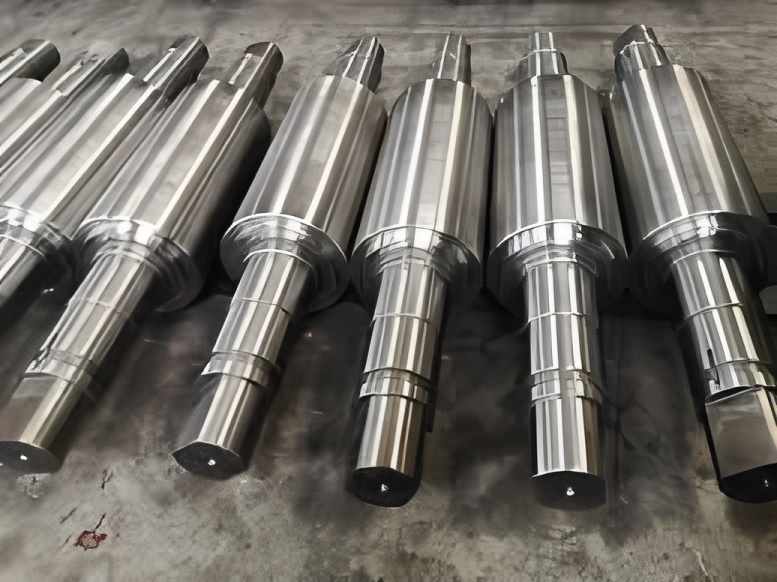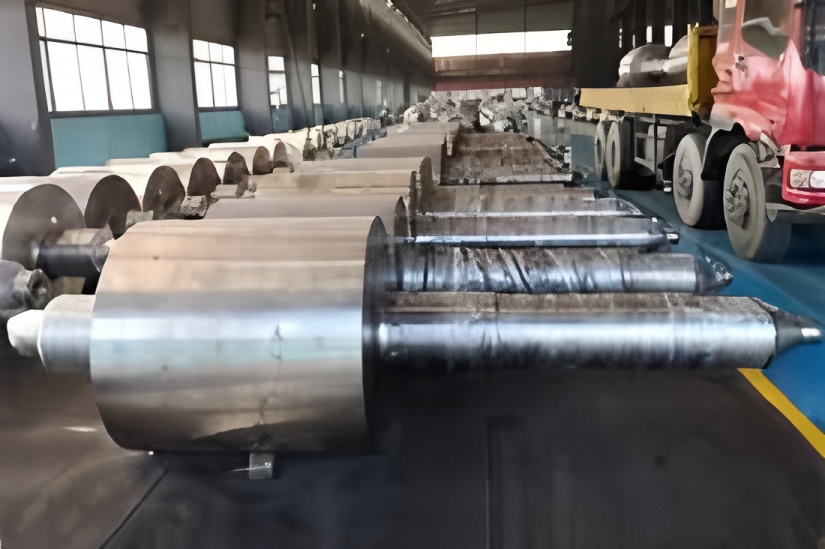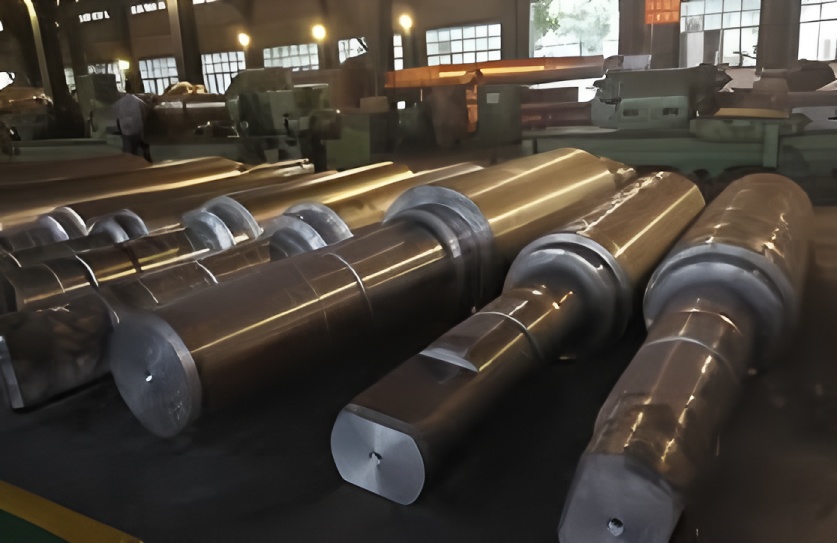This article details the composition and manufacturing process of cold rolling rolls.
Keywords: cold rolling roll; composition; manufacturing process
Cold Rolling Rolls: The rolls utilized in cold rolling are typically flat rolls employed for processing plates and strips. Broadly, cold rolling rolls encompass both work rolls, which contact the rolled material, and backup rolls that provide support. As backup rolls function as independent units, the term “cold roll” often specifically refers to cold-rolled work rolls. Cold rolling rolls must possess sufficient strength, uniformly high hardness, and superior surface quality to withstand extreme rolling forces, ensure adequate wear resistance, and meet the precision requirements of rolled products. Among forged steel rolls, those that can be hardened to high strength are used as cold rolls.
Carbon serves as the primary strengthening element. Part of the carbon is dissolved in the matrix phase—specifically in martensite and retained austenite—while the rest exists in the form of undissolved carbides, which are finely dispersed within the matrix. High carbon content enhances wear resistance but also increases material brittleness and can exacerbate issues like carbide banding, networking, and liquid precipitation. Thus, mills with high accident rates should opt for rolls with lower carbon content, while those under lighter loads may use higher-carbon rolls. Silicon and manganese are generally not considered alloying elements; they are either introduced through raw materials or added for deoxidation and desulfurization.
Chromium is the most crucial alloying element. As a strong carbide-forming element, it increases the amount and hardness of undissolved carbides, thereby improving wear resistance. Chromium also dissolves in the matrix, providing strengthening effects and enhancing the hardenability of the steel. With conventional chromium content, the maximum hardening depth of the roll body is 15 mm. Cold rolled rolls containing 3% or more chromium (semi-high-speed steel) have been developed to improve toughness, wear resistance, and achieve deeper hardened layers. Molybdenum functions similarly to chromium. During material deformation in the roll gap, high deformation heat is generated, and molybdenum contributes to high-temperature strengthening. Vanadium is used to refine grains, with its dosage dependent on the quenching temperature. Other alloying elements such as nickel, silicon, and tungsten are occasionally used.

Materials and Properties
This refers mainly to the chemical composition, metallographic structure, hardness, and strength of the roll.
Chemical Composition
The steel for forged cold rolls is primarily high-carbon chromium steel, with a typical composition (%) as follows: C 0.7–1.0, Si 0.25–0.5, Mn 0.25–0.5, Cr 1.5–5.5, Mo 0.2–0.6, V 0.1–0.2.
Metallographic Structure
The metallographic structure of the hardened layer in a cold roll body consists of a certain amount of undissolved quenched carbides distributed in a martensitic matrix containing a small amount of retained austenite. Under an optical microscope, the martensite appears cryptocrystalline or fine-needle-like. Due to the very low tempering temperature, no obvious tempering of martensite is observed. Under an electron microscope, both twinned and lath martensite can be seen, though twinned martensite predominates. A small amount of lath martensite may appear only at lower quenching temperatures or with higher chromium content.
The strain energy accompanying martensitic transformation critically influences transformation kinetics, leaving some of the parent phase (austenite) as retained austenite. As an unstable and plastic phase, retained austenite may partially transform or work-harden during service, increasing internal stress and impairing performance. Untransformed retained austenite can still benefit the toughness of the hardened layer. Its content is generally controlled between 5% and 10%.
Carbide particles in cold rolled steel are mainly (Fe, Cr)₃C, with some (Fe, Cr)₇C₃ forming at higher chromium levels. Carbide particles are typically 1–3 μm in size and account for about 5–10% of the structure.
Hardness
Hardness is a key parameter determining metal wear behavior and is regarded as the primary performance indicator for the roll body’s working layer in engineering. Only the working layer is hardened; unless specified, roll hardness refers to the body hardness. Hardness is usually measured with a Shore durometer. Work rolls for cold strip mills have a hardness of about 90–95 HS; flat rolls are about 95–100 HS. Foil rolls measure around 61–64 HRC. Hardness is influenced by residual compressive stress in the roll body: higher residual stress results in higher hardness. Thus, mills with lighter loads use higher-hardness rolls, while those with high accident rates require lower-hardness rolls. The roll neck typically has a hardness of only 30–50 HS, but with evolving bearing structures, some cold rolls now require hardened necks, generally below 80 HS after quenching.
Strength
Parts not in direct contact with the rolled material, such as the roll body core and neck, transmit rolling force, making strength their primary performance characteristic. Unless specified, roll strength refers to the lower roll neck strength. The strength of cold rolled rolls depends on pretreatment before quenching: spheroidizing pretreatment yields strength around 600 MPa; normalizing about 950 MPa; and quenching and tempering about 1050 MPa.
Manufacturing Process
Key steps in cold roll manufacturing include smelting, forging, heat treatment, machining, and inspection.
Smelting
Steel for cold rolling rolls must be smelted to high cleanliness standards. Common equipment includes alkaline electric furnaces, acid open-hearth furnaces, and vacuum ingot casting units. Secondary metallurgical methods like electroslag remelting or vacuum melting of consumable electrodes can enhance molten steel cleanliness. Depending on plant equipment, other refining methods may be used for degassing, desulfurization, inclusion removal, and composition adjustment. Ingots should be polygonal with a wave surface and big-end-up design.
Forging
After demolding, ingots are hot-transferred to the forging shop to be forged into billets. Forging shapes the roll and breaks down the coarse as-cast structure, particularly carbide networks, while reducing segregation and defects like shrinkage cavities, porosity, and microcracks. This refining, homogenizing, and densifying improves mechanical properties (strength and toughness) and prepares the microstructure for subsequent quenching. Hydraulic press free forging is typically used. Given the quality advantages, one ingot per roll is advisable. Key control parameters are temperature, anvil shape, and forging ratio. High forging temperatures can cause cracking; low temperatures impair diffusion and density. Surface cooling with center compaction is sometimes used. The final deformation should focus on the roll body, considering its final forging temperature. V-shaped anvils are common to promote metal axial flow. Anvil size affects elongation quality: too small causes incomplete forging; too large may cause cracks.
A sufficient forging ratio, generally above 3, is essential. After cutting ends, pressing handles, and chamfering, the ingot is upset first, then drawn out. During elongation, reduction must be controlled to avoid defects, and coaxiality between the ingot centerline and the finished product must be maintained. The forging process should be optimized based on ingot composition, shape, and forging size. Very small rolls can be made directly from slabs.
Heat Treatment
Post-forging, billets should be furnace-annealed. Slow cooling yields a flaky pearlite matrix with carbides still networked. If not shipped as is, normalized cooling can break carbide networks, and isothermal annealing can produce a granular pearlite matrix. If needed, final annealing allows hydrogen diffusion. To eliminate network carbides and spheroidize the matrix, normalize first, then spheroidize; this can be simplified to normalizing and high-temperature tempering if carbides are intermittent. Large rolls require special cooling during normalizing.
Rough-machined rolls must undergo quenching and tempering. This process treats the core and neck to required strength and hardness and prepares the structure for final body quenching. If strength requirements are low, direct quenching may be used. Oil or spray cooling is used for tempering; spray allows deeper tempering.
Quenching is critical for cold rolls. Early methods involved overall heating with jacketed neck protection; now, medium or power frequency induction heating—single or dual-frequency, integral or mobile—is common. Flame heating can also achieve rapid heating. High-pressure water quenches the roll, with cooling continued post-quench. Low-temperature tempering should follow promptly. Rolls with very low retained austenite require cold treatment before tempering. For rolls with center holes, water should flow through during quenching to accelerate core cooling.
Machining
After annealing, rough machining is performed. To reduce quenching risks, cold rolls often have a center hole, whose surface quality must be high to prevent fatigue damage. If hydrogen content and residual stress are controlled, the center hole may be omitted. Machining allowance should ensure no decarburized layer remains, avoid defects hindering quenching, minimize finishing allowance, and keep post-quench grinding minimal. Finishing and grinding occur pre- and post-quenching, respectively. Cold rolls demand high dimensional accuracy, concentricity, and surface finish. High residual stress requires careful selection of grinding wheels and parameters to prevent cracks. Specialized, preferably CNC, machine tools are used.
Inspection
Beyond routine material checks, cold rolls undergo product inspections. Machining accuracy is conventionally verified. Hardness measurement includes three metrics: average hardness, uniformity, and depth distribution. Routine tests cover the first two. Shore hardness tests must follow specified conditions, especially regarding measurement points, counts per point, averaging, and uniformity. Other hardness testers must use pre-specified conversion tables.
Non-destructive testing typically uses ultrasonic flaw detectors. Standards divide the roll body into surface, central, and intermediate zones based on stress, defining permissible defect sizes per fracture mechanics principles. Inspectors need knowledge of roll manufacturing to identify defects and of roll usage to assess service risks under specific conditions.
Residual stress in cold rolls results from uncoordinated deformation during quenching. Rapid cooling causes the outer layer to enter an elastic state quickly, hindering core contraction later and compressing the surface while stretching the core. Phase transformation stress also plays a role: martensitic transformation in the outer layer increases specific volume significantly, while pearlite transformation inward increases less, raising surface compressive stress. This surface compression enhances hardness, but core tension increases fracture risk. Residual stress affects hardness, wear resistance, contact fatigue resistance, strength (core tensile and surface indentation resistance), fatigue strength, thermal crack resistance, and even post-peening roughness. Residual stress measurement is not routine; surface stress is measured via X-ray, while depth distribution requires destructive testing with strain gauges or X-ray during stress release.
Maintenance
Maintenance includes intermediate grinding, roughening, and re-quenching.
Intermediate Grinding
Intermediate grinding removes surface cracks from previous service. New eddy current flaw detectors on grinding beds monitor residual cracks in real time, optimizing grind depth and preventing spalling accidents.
Roughening
Some strip products require deep drawing, coating, or coil annealing, necessitating rough-surface rolls in finishing and skin pass mills. Traditional roughening uses shot blasting, with roughness depending on shot quality, speed, and number of passes. Electric pulse and laser roughening are newer methods offering precise control.

Re-quenching
Re-quenching is possible when the hardened layer is depleted but minimum diameter remains. Tempering before re-quenching relieves stress and fully tempers the semi-martensitic zone. Re-quenched rolls are generally inferior to new ones, so parameters should minimize quenching stress.
Other Types of Cold Rolls
Centrifugally cast high-chromium cast steel rolls are cautiously used in cold strip rolling for their simpler process, no need for re-quenching, and high rolling capacity. They suit mills with few accidents and stable operations.
Temper mill work rolls, intermediate rolls, and some rolls in six-high and eight-high mills use the same material as four-high mill work rolls: forged and quenched high-carbon chromium steel. This grade is also used for straightening and other auxiliary rolls.
Sendzimir mill work rolls are made of high-carbon, high-chromium cold-work die steel or high-speed steel; intermediate rolls use medium-alloy cold-work die steel.
Carbide rolls are mainly used in cold rolling for flattening steel wires and producing flat wires or hairsprings. Their high hardness and wear resistance enable high-precision, high-quality products, making them suitable for foil rolling.


